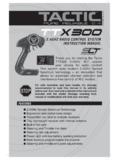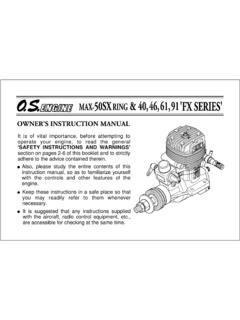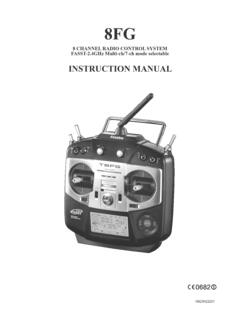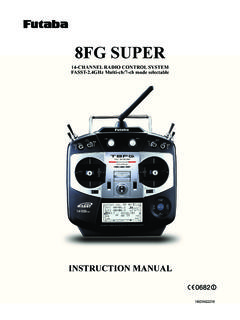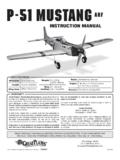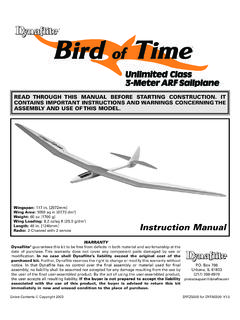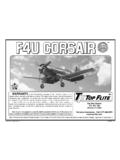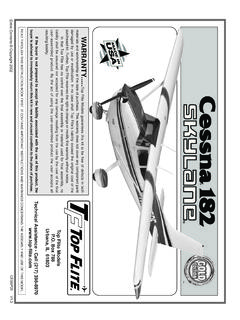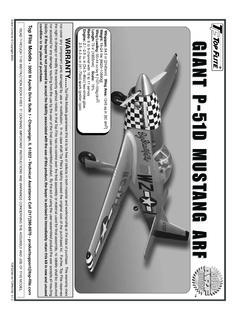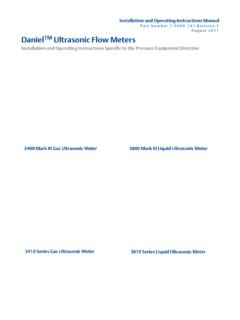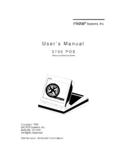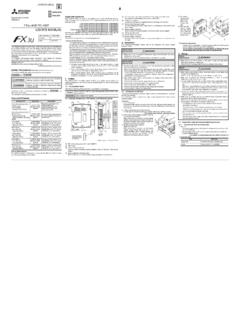Transcription of 'SAFETY INSTRUCTIONS AND WARNINGS' - …
1 It is of vital importance, before attempting to operate your engine, to read the general ' safety INSTRUCTIONS AND warnings '. section on pages 2-4 of this booklet and to strictly adhere to the advice contained therein. Also, please study the entire contents of this instruction manual, so as to familiarize yourself with the controls and other features of the engine. Keep these INSTRUCTIONS in a safe place so that you may readily refer to them whenever necessary. It is suggested that any INSTRUCTIONS supplied with the aircraft, radio control equipment, etc., are accessible for checking at the same time. CONTENTS. safety INSTRUCTIONS AND STARTING 13. warnings ABOUT YOUR ENGINE 2~4. RUNNING-IN 13~14. INTRODUCTION, installing THE GLOWPLUG 5. IDLING MIXTURE ADJUSTMENT 15. RELOCATION OF CARBURETTOR CONTROLS 6. VALVE ADJUSTING 15~17. FUEL TANK, INSTALLATION 7. CARE AND MAINTENANCE 17~18. EXHAUST HEADER PIPE AND SILENCER, THROTTLE LINKAGE, GENUINE PARTS & ACCESSORIES 19.
2 NEEDLE-VALVE EXTENSION 8. ENGINE EXPLODED VIEWS &. FUEL LINES 9 ENGINE PARTS LISTS 20~21. CARE OF FUEL PUMP AND REGULATOR, CARBURETTOR EXPLODED VIEWS &. PROPELLERS 9~10 PARTS LIST 22. GLOWPLUGS, FUEL 11~12 ENGINE THREE VIEW DRAWINGS 23. PROPELLER AND SPINNER ATTACHMENT, TYPE 70N CARBURETTOR 12. 1. safety INSTRUCTIONS AND. warnings ABOUT YOUR warnings . ENGINE. Remember that your engine is not a " toy ", but a highly Nevertouch, or allow any object to come into contact with, the rotating propeller and do not efficient internal-combustion machine whose power is crouch over the engine when it is running. capable of harming you, or others, if it is misused or abused. As owner, you, alone, are responsible for the safe A weakened or loose propeller may disintegrate or be thrown operation of your engine, so act with discretion and care at off and, since propeller tip speeds with powerful engines may exceed 600 feet(180 metres) per second, it will be understood all times.
3 That such a failure could result in serious injury, (see 'NOTES'. If at some future date, your engine is acquired by section relating to propeller safety ). another person, we would respectfully request that these INSTRUCTIONS are also passed on to its new owner. Model engine fuel is poisonous. Do not allow it to come into contact with the eyes or mouth. Always The advice which follows is grouped under two headings store it in a clearly marked container and out of according to the degree of damage or danger which the reach of children. might arise through misuse or neglect. Model engine fuel is also highly flammable. Keep it away from an open flame, excessive heat, sources warnings of sparks, or anything else which might ignite it. Do not smoke or allow anyone else to smoke, near These cover events which might involve serious ( in to it. extreme circumstances, even fatal ) injury. Neveroperate your engine in an enclosed space.
4 Model engines, like automobile engines, exhaust deadly carbon- monoxide. Run your engine only in an open area. NOTES Model engines generate considerable heat. Do not touch any part of your engine until it has These cover the many other possibilities, generally less cooled. Contact with the muffler(silencer), obvious sources of danger, but which, under certain cylinder head or exhaust header pipe, in circumstances, may also cause damage or injury. particular, may result in a serious burn. 2. NOTES. This engine was designed for model aircraft. Do not attempt to use it for any other purpose. Mount the engine in your model securely, following the manufacturers' recommendations, using appropriate screws and locknuts. Be sure to use the silencer (muffler) supplied with the engine. Frequent exposure to an open exhaust may eventually impair your hearing. Such noise is also likely to cause annoyance to others over a wide area.
5 Fit a top-quality propeller of the diameter and pitch specified for the engine and aircraft. Locate the propeller on the shaft so that the curved face of the blades faces in the direction of flight. Firmly tighten the propeller nut, using the correct size wrench. Always check the tightness of the propeller nut and retighten it, if necessary, before restarting the engine, particularly in the case of four-stroke-cycle engines. A safety locknut assembly is provided. Always use it. This will prevent the propeller from flying off in the event of a "backfire", even if it loosens. If you fit a spinner, make sure that it is a precision made product and that the slots for the propeller blades do not cut into the blade roots and weaken them. Discard any propeller which has become split, cracked, nicked or otherwise rendered unsafe. Never attempt to repair such a propeller: destroy it. Do not modify a propeller in any way, unless you are highly experienced in tuning propellers for specialized competition work such as pylon-racing.
6 Use an electric starter for this engine. The wearing of safety glasses is also strongly recommended. 3. NOTES. Take care that the glow plug clip or battery leads do not come into contact with the propeller. Also check the linkage to the throttle arm. A disconnected linkage could also foul the propeller. After starting the engine, carry out any needle-valve readjustments from a safe position behind the rotating propeller. Stop the engine before attempting to make other adjustments to the carburettor. Adjust the throttle linkage so that the engine stops when the throttle stick and trim lever on the transmitter are fully retarded. Alternatively, the engine may be stopped by cutting off the fuel supply. Never try to stop the engine physically. Take care that loose clothing (ties, shirt sleeves, scarves, etc.) do not come into contact with the propeller. Do not carry loose objects (such as pencils, screwdrivers, etc.)
7 In a shirt pocket from where they could fall through the propeller arc. Do not start your engine in an area containing loose gravel or sand. The propeller may throw such material in your face and eyes and cause injury. For their safety , keep all onlookers (especially small children) well back (at least 20 feet or 6 meters) when preparing your model for flight. If you have to carry the model to the take-off point with the engine running, be especially cautious. Keep the propeller pointed away from you and walk well clear of spectators. Warning! Immediately after a glowplug-ignition engine has been run and is still warm, conditions sometimes exist whereby it is just possible for the engine to abruptly restart if the propeller is casually flipped over compression WITHOUT the glowplug battery being reconnected. Remember this if you wish to avoid the risk of a painfully rapped knuckle! 4. INTRODUCTION. The FS-120S3 is the latest mid-range model in the well-estab- lished FS-120S series of 20cc four-stroke engines.
8 This series F-5020 Silencer extends from the standard suction-feed FS-120S-E to the unique ultra-high performance FS-120S-SP, the world's only production model engine to be equipped with a genuine crank- Exhaust Header Pipe shaft-driven supercharger. The FS-120S3 is fitted with the new PD-07 diaphragm type fuel pump and matching Type 70N carburettor incorporat- Rocker Cover ing a built-in pressure regulator. These features ensure that fuel/air mixture strength is maintained at a constant level Cylinder Head Carburettor Type 70N. through manoeuvres, for consistent performance and reliable throttle response. In the interests of improved durability, certain ferrous parts that are particularly susceptible to corrosion in four-stroke engines, have a corrosion resistant plating and, for the same reason, a Push Rod Cover special grease-packed twin-sealed rear ball-bearing is used. To maintain the four-stroke engine's reduced noise levels, the FS-1203 is supplied with an Type F-5020 baffled silencer (muffler) of substantially enlarged volume, as standard equip- Drive Hub ment.
9 Where installation calls for a separate exhaust pipe and silen- cer, these parts are available as optional extras. (See page 19. of this booklet.) Cover Plate installing THE GLOW PLUG Beam Mount Carefully insert plug, with washer, Propeller Washer fingertight only, before final tightening Lock Nut Propeller Nut Crankcase with the correct size plug wrench. Glow plug Washer 5. RELOCATION OF CARBURETTOR CONTROLS FS-91S2-P. As supplied, the FS-120S3 has its throttle lever on the right hand side and needle-valve control on the left. However, where more convenient for certain installations, these positions may be Intake Pipe reversed after rotating the carburettor through 180 horizontally. Mounting Screw Proceed as follows: 1. Remove the intake pipe mounting screws from the cylinder head Intake Pipe (taking care not to lose the flange gasket) and the carburettor mounting screws from the crankcase cover plate bracket.
10 Needle Valve 2. Detach short tube connecting the carburettor to the pump unit and gently rotate the carburettor through 180 without separating it from the intake pipe or removing the enclosed O- ring seal. Pressure Regulator 3. Re-install the complete sub-assembly of intake pipe and carburettor, making sure that adjoining surfaces are clean. Tighten screws evenly and firmly but not excessively. 4. Remove pump mounting screws from the crankcase cover plate lugs, carefully rotate the pump clockwise one-quarter turn Carburettor and attach it to the second pair of lugs provided, taking care that Mounting Screw the central tube connecting the crank chamber to the pump diaphragm chamber is not twisted. FueI Inlet 5. Finally, make sure that all external tube connections are secure Pump Fixing Screw and do not leak. PD-07 Pump Throttle Lever 6. Make sure that these mounting beams are accurately aligned and FUEL TANK firmly integrated with the airframe, reinforcing the adjacent A fuel tank of approximately 450cc capacity is suggested.
